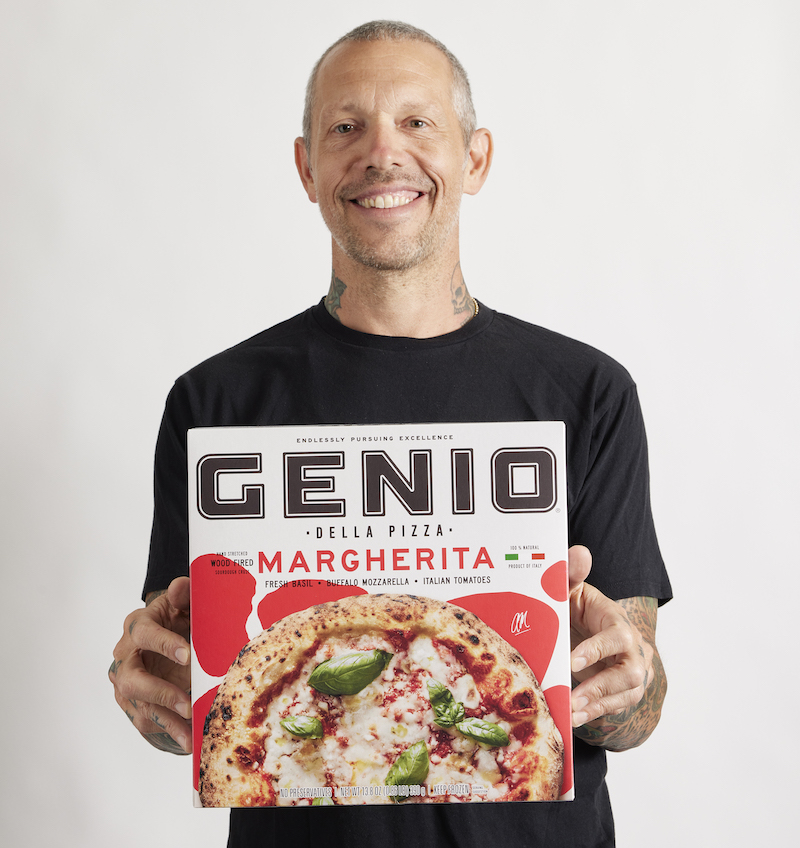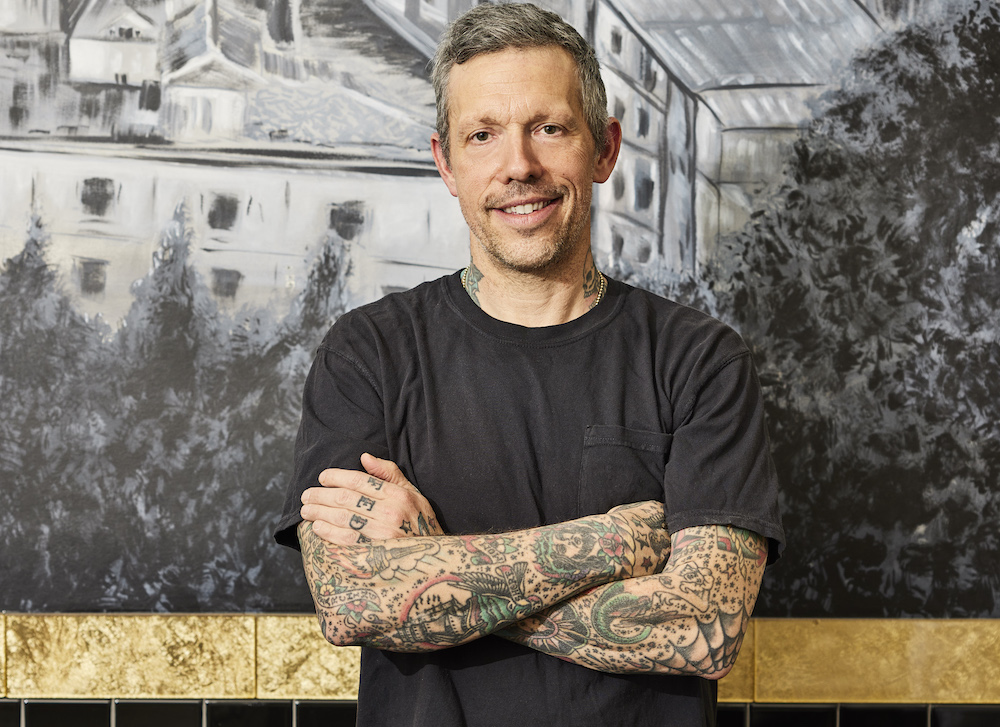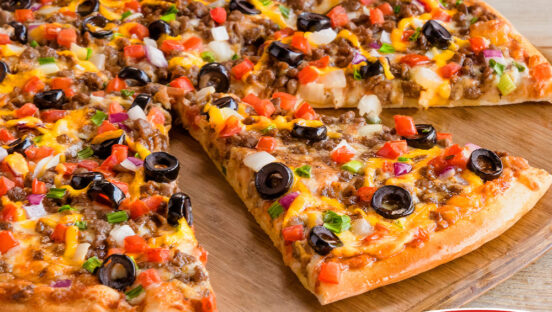If you think getting into the frozen pizza business is a breeze, Anthony Mangieri, one of the best and most celebrated pizzaiolos in the world, has a word of warning for you: It’s even harder than running a restaurant, he says.
And Mangieri should know. He’s the culinary wizard behind Una Pizzeria Napoletana in New York City as well as the creator of the new frozen pizza brand, Genio Della Pizza, which launched last year.
It took Mangieri three years to perfect his recipes for Genio Della. Then he had to clear more hurdles than a dog-show contestant to get it into grocery stores. All of this despite the fact that Una Pizzeria Napoletana has been ranked the best pizzeria in the U.S. by 50 Top Pizza two years in a row (2022 and 2023) and the best in the world in 2022.
Related: How 7 pizzerias made this best-places-to-eat list from Yelp
Fortunately, Genio Della Pizza, as soon as it launched, started getting its own rave reviews, including from The New York Times and the San Francisco Chronicle. Now, after cracking the code for superior frozen pizza, Mangieri is in the process of making his pies available in every state in the country.
Mangieri recently spoke with PMQ’s Tracy Morin about the challenges (and heartaches) of breaking into frozen pizza and the consumer packaged goods (CPG) industry. Here are some of the highlights of that discussion:

Genio Della Pizza
PMQ: Why did you want to launch a frozen pizza line?
Mangieri: I guess anybody would start to think, “Obviously, I’m limiting my growth abilities here by choosing to do things this way. So is there something else I could do to grow as a businessperson and also connect with people on a larger scale than just in my restaurant?” We’re open a few nights a week. Una has super long waits with 1,000 people on the “notify” lists every night, so it’s not always the easiest place to get into—or you might not live in New York.
So I thought about different things—tomatoes, olive oil, pizza—and then finally landed on the idea that I would try to do a frozen pizza. And that was the start of Genio Della Pizza, about three years ago. I was doing R&D, trying to find someone that could produce it with me, because I didn’t really want to produce the pizza in the restaurant. I felt like that would dilute what I do in the restaurant, so I wanted it to be separate. Instead, I could use my knowledge—and hopefully my skill from 30 years of making pizza—to create this frozen pizza. But not to be like, “Hey, this is Una pizza,” because I felt like that would not be fair to my 30 years at Una. I wouldn’t want people to try it in Ohio or whatever and say, “This is what they make at Una?” Because it’s frozen pizza. It’s not what we make at Una, which is 130 or 150 pizzas a night, me balling every single one of them and working the line every single night. It’s a completely different product. This is something I wanted to do that was scalable.
That’s why I also didn’t name it Una Pizza or Anthony Mangieri. I named it something that was separate from the restaurant and myself, but I’m on the back of the box, and I’ve given it all my love. I actually am present and go to Italy every single time we do a production run. I’m in the factory, and I make the pizza and run around driving everyone nuts, telling them that we need to turn the oven temperature up or lower, add more cheese or less cheese, and all that. So I’ve tried to give it the same attention to detail that I’ve given Una, but with the idea that it’s something that is accessible to people outside of the restaurant.
PMQ: Why did you choose to produce the line in Italy for sales in the U.S.?
Mangieri: When I began the R&D three years ago, I first wanted to make it in the U.S., because it’d be easier to control it. But I just could not find anyone in the entire United States or Canada who had the skill set, the knowledge or the ability to produce something like this. There’s nobody really using wood-fired ovens in the U.S. that’s a scalable business. To work at scale, the ingredients need to be packaged in certain size containers—it’s just such a different world than the restaurant world. There was a lot to learn. I realized pretty quickly I couldn’t get the ingredients that I would want to use to make the best product for the frozen line. How am I gonna get Italian tomatoes into the U.S. that are in the right container size that we use in a co-packers setting—plus the mozzarella, all this stuff? It was impossible. And then to top it off, no co-packer I found in the U.S. or Canada understood or had the skill to do this with a wood-burning oven.
Related: Why do legendary Brooklyn pizza shops keep closing down?

The Margherita pizza (Mark Weinberg)
PMQ: What have you learned along the way about the frozen food and grocery-store world?
Mangieri: The first thing that I’ve learned—and I’m still trying to wrap my head around it—is the sales side of things. To most of us who have restaurants, we care about the food. The food is No. 1, quality is No. 1….This business is so different…it’s not even about the food. Food stores, brokers and the whole CPG world are pretty heartbreaking when you come from the restaurant world, where you’re used to being around other like-minded people, where chefs talk about the things that get them excited. [In CPG], it tends to be more like, here’s the promos we need, here’s our margins we need every month, and you need to do this, this and this, or you’re not coming into the store, and that’s it. They don’t necessarily even care about what it tastes like or anything else.
A lot of times when you try [frozen] products, you’re like, “This is really not that good, it doesn’t really need to exist, it’s not better than what’s already existed.” Ultimately, I think that’s been the hardest thing for me to learn and understand. I’ll send samples to food store buyers, and they don’t even like it. And I’m like, “What the hell are you talking about—you tell me what frozen pizza you like better.” They like the big legacy brands, where it’s super salty and has a taste that I don’t personally identify with. But I get that it’s a flavor profile that people have grown up with, that American consumers are used to. But for me, when I cook one of our frozen pizzas, it smells like bread, it smells like food. And when you eat it, it tastes like food…I wanted something that tasted like an Italian bakery and smelled good when you’re cooking it at home or for your kids.
The other pretty crazy thing was working at such scale—kind of approaching it like I would approach the pizzeria, but just way bigger. Like, what do I do in the restaurant when the dough isn’t coming out right or when the oven isn’t working right? But then you’re trying to understand and learn and grow to be able to handle that at scale—also with a lot of people handling the product, which was new to me. I’ve had my two guys that have been with me for years, and no one else ever touches any of the product [at the pizzeria]. To try to let go of that and be able to deal with that kind of world and be better at delegating, it’s been a lot for me to learn.
Related: This chef serves a Detroit-style pizza like you’ve never seen
PMQ: That sounds pretty complex. How do you manage it?
Mangieri: If you’re coming from a pizzeria or restaurant world and want to get into the retail side, I think it’s about trying to learn how to delegate, and how to make what you make scalable—because, ultimately, if you’re going to do retail, you have to figure out how to make a product that is scalable. And that’s something that we really wanted to spend a lot of time with. That’s why it took so long with the R&D. I didn’t want to come out with a product that, let’s say, I made at the pizzeria on the days we’re not open and sold frozen—it’d be amazing. But then, say, I get it into a Whole Foods and want to go national. Then it’s like, “Okay, let me now go back to the drawing board and find a co-packer and figure out how to make this scalable.”
Instead, I went out in the beginning knowing that I already make a handmade product that is super limited. So I started, right from the beginning, asking, “How can I make something that, from [the moment] you first tasted it, that’s the worst it’s ever gonna be? It’s only gonna get better as I keep learning and keep growing. But it’s not gonna get worse.” So I get into Whole Foods. And they’re like, “We love this.” One of the buyers told me it’s their favorite product on their shelf. And that’s really empowering, because I’m like, all right, now we’re in a good spot, because I know this was the worst it’ll ever be—because I already did all the R&D, and it’s already scalable. I’m only learning now, and I will continue to grow and understand more and how to be better. So I think that is important: If you want to get into retail, figure out how to make what you want to sell scalable, before you start presenting it. Don’t take what you make, freeze it or package it and try to get it out in the world, because that’s not going to be a fair representation of what you’ll end up doing when you do scale it. It’s two completely different businesses.
PMQ: What are your ultimate goals with the business in terms of growth?
Mangieri: It launched, I believe, the first week of February 2023, so it officially launched almost a year ago. I have a really small team, like three full-time employees that work with me on Genio. So there’s four of us, and we have a bunch of freelance people that do different things, like merchandising. I think our goal right now is to just keep getting better at what we’re doing and understand and navigate the landscape and grow in a way that’s meaningful and that makes sense. And try to make sure that whatever retail store we go into, we win in, and that it makes sense.
I mean, it’s a very, very difficult landscape to work with, especially frozen. Getting into the retail space is a nightmare, but frozen is the worst of all. Because it’s the most expensive to work within, it’s the most expensive to transport and store; the cost of storing this stuff is insane. And then trucking it, once it’s stored, to the food stores is super expensive. And the food stores have a lot of fees—slotting fees and things—because the freezer section is their most expensive section in the store. It’s the most limited, it’s plugged in, it’s expensive to maintain. The space is such that, to get on the shelf, somebody else has to get kicked off the shelf. It’s not like you go into a food store and there’s a bunch of empty freezer space, and you’re like, “Oh, I should create a brand and take up that empty space.” No—if you want to get in that space, you’re gonna knock somebody else off the shelf. So you need to prove why you should be in there. And if you’re not performing, they kick you off.
So, for us right now, we want to just grow in a way that makes sense. Because we’re not a huge company—we’re not Rao’s, for example, that launched a frozen pizza and instantly, overnight, was in every single food store in the U.S. That is a volume of money that’s being dumped into the market that few can compete with. The way to do that is, you go to food stores, and you just pay to get in, and you get in every store. But it costs millions and millions of dollars to do that, and we’re not that. So we have to be more thoughtful, try to grow in a way that makes sense, and make sure the retail stores we end up in have the customer base that’s going to care about getting an $11.99 frozen pizza that’s handmade in Italy, with buffalo mozzarella and fresh basil. And that’s sort of our growth plan right now.
Looking ahead seven years from now, 10 years from now, who knows? I don’t see a limit to this. I imagine, best case scenario, being in all the great food stores in the U.S., and it becomes a brand that, when people see the name, they trust it and know it’s something with quality, and they’re happy to share it with family and friends.













